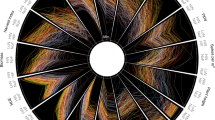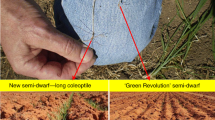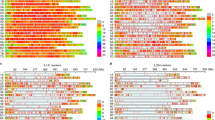Abstract
Global food security requires food production to be increased in the coming decades. The closure of any existing genetic yield gap (Yig) by genetic improvement could increase crop yield potential and global production. Here we estimated present global wheat Yig, covering all wheat-growing environments and major producers, by optimizing local wheat cultivars using the wheat model Sirius. The estimated mean global Yig was 51%, implying that global wheat production could benefit greatly from exploiting the untapped global Yig through the use of optimal cultivar designs, utilization of the vast variation available in wheat genetic resources, application of modern advanced breeding tools, and continuous improvements of crop and soil management.
This is a preview of subscription content, access via your institution
Access options
Access Nature and 54 other Nature Portfolio journals
Get Nature+, our best-value online-access subscription
$29.99 / 30 days
cancel any time
Subscribe to this journal
Receive 12 digital issues and online access to articles
$119.00 per year
only $9.92 per issue
Buy this article
- Purchase on Springer Link
- Instant access to full article PDF
Prices may be subject to local taxes which are calculated during checkout







Similar content being viewed by others
Data availability
The data that support the findings of this study are publicly available from http://www.fao.org/faostat/en/#data/QC and https://www.fao.org/aquastat/en/. All other data supporting the findings of this study are included within the article and supplementary information. Any further information regarding this study is available from the corresponding authors on request. Source data are provided with this paper.
Code availability
The Sirius model and the stochastic weather generator LARS-WG 6.0 used in the present study are available from https://doi.org/10.5281/zenodo.4572624 and https://doi.org/10.5281/zenodo.4572752, respectively.
References
Evenson, R. E. & Gollin, D. Assessing the impact of the Green Revolution, 1960 to 2000. Science 300, 758–762 (2003).
FAOSTAT (Food and Agriculture Organization of the United Nations, accessed 28 July 2021); http://www.fao.org/faostat/en/#data/QC
Stewart, B. A. & Lal, R. Chapter one—increasing world average yields of cereal crops: it’s all about water. Adv. Agron. 151, 1–44 (2018).
van Dijk, M., Morley, T., Rau, M. L. & Saghai, Y. A meta-analysis of projected global food demand and population at risk of hunger for the period 2010–2050. Nat. Food 2, 494–501 (2021).
Foley, J. A. et al. Solutions for a cultivated planet. Nature 478, 337–342 (2011).
Godfray, H. C. J. et al. Food security: the challenge of feeding 9 billion people. Science 327, 812–818 (2010).
Shiferaw, B. et al. Crops that feed the world 10. Past successes and future challenges to the role played by wheat in global food security. Food Secur. 5, 291–317 (2013).
The 17 Goals (United Nations Department of Economic and Social Affairs Sustainable Development, Division for Sustainable Development Goals, 2021).
Fischer, R. A., Byerlee, D. & Edmeades, G. O. Crop Yield and Global Food Security: Will Yield Increase Continue to Feed the World? ACIAR Monograph Vol. 158 (ACIAR, 2014).
Lobell, D. B., Cassman, K. G. & Field, C. B. Crop yield gaps: their importance, magnitudes, and causes. Annu Rev. Environ. Resour. 34, 179–204 (2009).
van Ittersum, M. K. et al. Yield gap analysis with local to global relevance—a review. Field Crops Res. 143, 4–17 (2013).
Senapati, N. & Semenov, M. A. Large genetic yield potential and genetic yield gap estimated for wheat in Europe. Glob. Food Secur. 24, 100340 (2020).
Senapati, N. & Semenov, M. A. Assessing yield gap in high productive countries by designing wheat ideotypes. Sci Rep. 9, 5516 (2019).
Donald, C. M. The breeding of crop ideotypes. Euphytica 17, 385–403 (1968).
Cooper, M. et al. Integrating genetic gain and gap analysis to predict improvements in crop productivity. Crop Sci. 60, 582–604 (2020).
Dowla, M., Edwards, I., O’Hara, G., Islam, S. & Ma, W. Developing wheat for improved yield and adaptation under a changing climate: optimization of a few key genes. Engineering 4, 514–522 (2018).
Hall, A. J. & Richards, R. A. Prognosis for genetic improvement of yield potential and water-limited yield of major grain crops. Field Crops Res. 143, 18–33 (2013).
Reynolds, M. et al. Raising yield potential in wheat. J. Exp. Bot. 60, 1899–1918 (2009).
Gbegbelegbe, S. et al. Baseline simulation for global wheat production with CIMMYT mega-environment specific cultivars. Field Crops Res. 202, 122–135 (2017).
Rajaram, S., van Ginkel, M. & Fischer, R. A. CIMMYT’s wheat breeding mega-environments (ME). In Proceedings of the 8th International Wheat Genetic Symposium (eds Li, Z. S. & Xin, Z. Y.) 1101–1106 (China Agricultural Scientech Press, 1995).
Semenov, M. Sirius Crop Model (Sirius 2018) (Zenodo, 2021); https://doi.org/10.5281/zenodo.4572624
Senapati, N., Stratonovitch, P., Paul, M. J. & Semenov, M. A. Drought tolerance during reproductive development is important for increasing wheat yield potential under climate change in Europe. J. Exp. Bot. 70, 2549–2560 (2019).
AQUASTAT (Food and Agriculture Organization of the United Nations, accessed 17 May 2021); http://www.fao.org/aquastat/en/databases/
GYGA. Global Yield Gap and Water Productivity Atlas (accessed 22 October 2021); www.yieldgap.org
Schils, R. et al. Cereal yield gaps across Europe. Eur. J. Agron. 101, 109–120 (2018).
Hammer, G. L., Cooper, M. & Reynolds, M. P. Plant production in water-limited environments. J. Exp. Bot. 72, 5097–5101 (2021).
Senapati, N., Griffiths, S., Hawkesford, M., Shewry, P. R. & Semenov, M. A. Substantial increase in yield predicted by wheat ideotypes for Europe under future climate. Clim. Res. 80, 189–201 (2020).
Hatfield, J. L. & Beres, B. L. Yield gaps in wheat: path to enhancing productivity. Front. Plant Sci. 10, 1603 (2019).
Fischer, R. A. & Connor, D. J. Issues for cropping and agricultural science in the next 20 years. Field Crops Res. 222, 121–142 (2018).
Semenov, M. A. & Terkel, D. A. Analysis of convergence of an evolutionary algorithm with self-adaptation using a stochastic Lyapunov function. Evol. Comput. 11, 363–379 (2003).
Stratonovitch, P. & Semenov, M. A. Calibration of a crop simulation model using an evolutionary algorithm with self-adaptation. Proc. Social Behav. Sci. 2, 7749–7750 (2010).
Reynolds, M. et al. Breeder friendly phenotyping. Plant Sci. 295, 110396 (2020).
Cooper, M., Voss-Fels, K. P., Messina, C. D., Tang, T. & Hammer, G. L. Tackling G × E × M interactions to close on-farm yield-gaps: creating novel pathways for crop improvement by predicting contributions of genetics and management to crop productivity. Theo. Appl. Genet. 134, 1625–1644 (2021).
Asseng, S. et al. Climate change impact and adaptation for wheat protein. Glob. Change Biol. 25, 155–173 (2019).
Liu, B. et al. Global wheat production with 1.5 and 2.0 °C above pre-industrial warming. Glob. Change Biol. 25, 1428–1444 (2019).
Martre, P. et al. Multimodel ensembles of wheat growth: many models are better than one. Glob. Change Biol. 21, 911–925 (2015).
Wang, E. et al. The uncertainty of crop yield projections is reduced by improved temperature response functions. Nat. Plants 3, 17102 (2017).
Semenov, M. A. & Stratonovitch, P. Adapting wheat ideotypes for climate change: accounting for uncertainties in CMIP5 climate projections. Clim. Res. 65, 123–139 (2015).
Brooks, R. J., Semenov, M. A. & Jamieson, P. D. Simplifying Sirius: sensitivity analysis and development of a meta-model for wheat yield prediction. Eur. J. Agron. 14, 43–60 (2001).
Asseng, S. et al. Rising temperatures reduce global wheat production. Nat. Clim. Change 5, 143–147 (2015).
Cooper, M. et al. Modelling selection response in plant-breeding programs using crop models as mechanistic gene-to-phenotype (CGM-G2P) multi-trait link functions in silico. Plants 3, diaa016 (2021).
Reynolds, M. et al. Addressing research bottlenecks to crop productivity. Trends Plant Sci. 26, 607–630 (2021).
Peng, S. B., Khush, G. S., Virk, P., Tang, Q. Y. & Zou, Y. B. Progress in ideotype breeding to increase rice yield potential. Field Crops Res. 108, 32–38 (2008).
Christopher, M. et al. QTL for stay-green traits in wheat in well-watered and water-limited environments. Field Crops Res. 217, 32–44 (2018).
Royo, C., Dreisigacker, S., Alfaro, C., Ammar, K. & Villegas, D. Effect of Ppd-1 genes on durum wheat flowering time and grain filling duration in a wide range of latitudes. J. Agric. Sci. 154, 612–631 (2016).
Pingali, P. L. Green Revolution: impacts, limits, and the path ahead. Proc. Natl Acad. Sci. USA 109, 12302–12308 (2012).
Senapati, N., Brown, H. E. & Semenov, M. A. Raising genetic yield potential in high productive countries: designing wheat ideotypes under climate change. Agric. Forest Meteorol. 271, 33–45 (2019).
Gouache, D. et al. Bridging the gap between ideotype and genotype: challenges and prospects for modelling as exemplified by the case of adapting wheat (Triticum aestivum L.) phenology to climate change in France. Field Crops Res. 202, 108–121 (2017).
Rötter, R. P., Tao, F., Höhn, J. G. & Palosuo, T. Use of crop simulation modelling to aid ideotype design of future cereal cultivars. J. Exp. Bot. 66, 3463–3476 (2015).
Christopher, J. T., Christopher, M. J., Borrell, A. K., Fletcher, S. & Chenu, K. Stay-green traits to improve wheat adaptation in well-watered and water-limited environments. J. Exp. Bot. 67, 5159–5172 (2016).
Manschadi, A. M., Christopher, J., deVoil, P. & Hammer, G. L. The role of root architectural traits in adaptation of wheat to water-limited environments. Func. Plant Biol. 33, 823–837 (2006).
Ramirez-Villegas, J., Watson, J. & Challinor, A. J. Identifying traits for genotypic adaptation using crop models. J. Exp. Bot. 66, 3451–3462 (2015).
Bustos, D. V., Hasan, A. K., Reynolds, M. P. & Calderini, D. F. Combining high grain number and weight through a DH-population to improve grain yield potential of wheat in high-yielding environments. Field Crops Res. 145, 106–115 (2013).
Zhu, X. G., Long, S. P. & Ort, D. R. Improving photosynthetic efficiency for greater yield. Ann. Rev. Plant Biol. 61, 235–261 (2010).
Acknowledgements
Rothamsted Research led this study and received grant-aided support from the Biotechnology and Biological Sciences Research Council (BBSRC) through Designing Future Wheat (BB/P016855/1) and Achieving Sustainable Agricultural Systems (NE/N018125/1). This study was also supported by the Agricultural Model Intercomparison and Improvement Project (AgMIP-Wheat) and the International Wheat Yield Program (IWYP115 Project). F.E. acknowledges support by the Deutsche Forschungsgemeinschaft (DFG, German Research Foundation) under Germany’s Excellence Strategy (EXC 2070), 390732324. M.K.v.I. acknowledges the Senior Expert Programme of NWO-WOTRO Strategic Partnership NL-CGIAR. P.M. acknowledges support from the metaprogramme Agriculture and forestry in the face of climate change: adaptation and mitigation (CLIMAE) of the French National Research Institute for Agriculture, Food and Environment (INRAE). J.E.O. acknowledges financial support from SustES—adaptation strategies for sustainable ecosystem services and food security under adverse environmental conditions (CZ.02.1.01/0.0/0.0/16_019/0000797). R.P.R. was financially supported by the BARISTA (Advanced tools for breeding BARley for Intensive and SusTainable Agriculture under climate change scenarios) project, grant number 031B0811A.
Author information
Authors and Affiliations
Contributions
N.S. and M.A.S. conceived the concept of the study, designed the simulation experiment, performed model simulations, analysed model outputs and wrote the first draft of the manuscript. All coauthors revised the manuscript. Authors from S.A. to H.W. are listed in alphabetical order.
Corresponding authors
Ethics declarations
Competing interests
The authors declare no competing interests.
Peer review
Peer review information
Nature Food thanks Brian Beres, Jerry Hatfield, Toshihiro Hasegawa and the other, anonymous, reviewer(s) for their contribution to the peer review of this work.
Additional information
Publisher’s note Springer Nature remains neutral with regard to jurisdictional claims in published maps and institutional affiliations.
Supplementary information
Supplementary Information
Supplementary Figs. 1–3, Tables 1–6, methods and references.
Supplementary Data 1
Potential yield, harvest index and coefficient of variation of yield of current wheat cultivars at country level under different irrigation conditions.
Supplementary Data 2
Wheat genetic yield potential, harvest index and coefficient of variation of yield potential at country level under different irrigation conditions.
Supplementary Data 3
Wheat genetic yield gap at country level under different irrigation conditions.
Source data
Source Data Fig. 1
Average global wheat grain yield (dry matter: DM t ha−1) and yields in the leading producer countries during 1961–2019.
Source Data Fig. 2
Potential yield of current wheat cultivars at country level.
Source Data Fig. 3
Potential yield of current wheat cultivars in CIMMYT mega-environments, and under different irrigation conditions and growth habits.
Source Data Fig. 4
Comparison of potential yield of current wheat cultivars estimated by Sirius and GYGA.
Source Data Fig. 5
Wheat genetic yield potential and genetic yield gap at a country level.
Source Data Fig. 6
Wheat genetic yield potential and genetic yield gap in CIMMYT mega-environments.
Source Data Fig. 7
Wheat genetic yield potential and genetic yield gap under different irrigation conditions and growth habits.
Rights and permissions
About this article
Cite this article
Senapati, N., Semenov, M.A., Halford, N.G. et al. Global wheat production could benefit from closing the genetic yield gap. Nat Food 3, 532–541 (2022). https://doi.org/10.1038/s43016-022-00540-9
Received:
Accepted:
Published:
Issue Date:
DOI: https://doi.org/10.1038/s43016-022-00540-9
This article is cited by
-
Global Suitability Analysis of Current and Future Climates for Rainfed Wheat Production
International Journal of Plant Production (2023)
-
Screening the Zymoseptoria tritici population in Turkey for resistance to azole and strobilurin fungicides
Journal of Plant Diseases and Protection (2023)
-
Raising wheat yield ceiling
Nature Food (2022)



